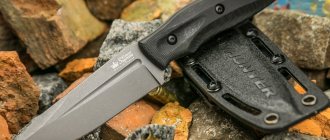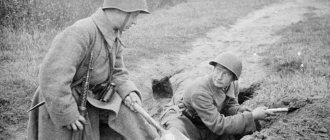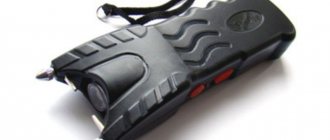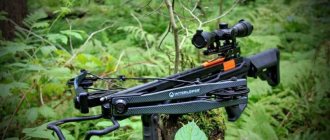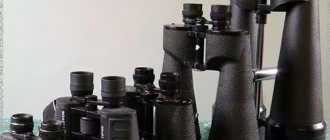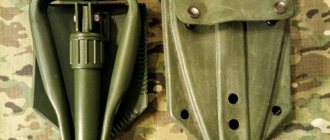Author: zaCCCPanec
January 22, 2022 10:29
Tags: MPL-50 Mads Linnemann pages of history
3190
12
The shovel was invented by man even before the advent of all monotheistic religions; the history of this entrenching tool goes back thousands of years. In ancient times, a tray, bayonet or shovel blade was made from bones or wood, then they began to be sheathed and forged with iron, and only then they came to all-metal versions.
0
See all photos in the gallery
Throughout history, shovels have been used by the military for the construction of fortifications and engineering work, but they became part of the equipment of every military personnel relatively recently, only in the final quarter of the 19th century. The Russian sapper shovel has become one of the most famous and famous throughout the world. Sapper shovel is a colloquialism that has become widespread and is very often used in written and oral speech; the meaning is non-statutory. The official name is small infantry shovel. For a long time, the Linnemann small infantry shovel, also known as MPL-50, was in service with the Russian Imperial Army, and then the Soviet Army.
The history of the appearance of the sapper shovel
The small sapper shovel was invented back in 1869, when the Dane Linnemann (who was an infantry captain) received a patent for it. In Denmark, the new product was received rather coolly, which is why Linnemann opened production not in his homeland, but in Austria in 1871. The captain received one of the first large orders for his shovel from the Russian tsarist army, which ordered 60,000 shovels for 30,000 rubles. The novelty was appreciated by the Russian infantry.
Due to its compactness and ease of use, this type of shovel quickly took root in armies around the world.
Around these years, the first instructions for using a small sapper shovel (MSS) appeared. These rules have been preserved to this day, only some features of the use of MSL (MPL) as a weapon have been added to them. In modern manuals, a small universal soldier's shovel is called both MSL and MPL (small infantry shovel). The appearance of the classic sapper shovel has changed little over the years, only the materials, design and dimensions have changed.
Although the name of the shovel contains the word “sapper”, it is used by all types of modern infantry, from simple motorized rifles to elite special forces units (however, for them there is a special forces sapper shovel of a folding design). The main purpose of a sapper shovel is to dig a trench or dig in, and this often has to be done under enemy fire. To create serious engineering structures, large engineer shovels (BSL) are used, which are similar in size and shape to ordinary bayonet shovels.
The most famous sapper shovel
The shovel was invented by man even before the advent of all monotheistic religions; the history of this entrenching tool goes back thousands of years.
In ancient times, a tray, bayonet or shovel blade was made from bones or wood, then they began to be sheathed and forged with iron, and only then they came to all-metal versions. Throughout history, shovels have been used by the military for the construction of fortifications and engineering work, but they became part of the equipment of every military personnel relatively recently, only in the final quarter of the 19th century.
The Russian sapper shovel has become one of the most famous and famous throughout the world. Sapper shovel is a colloquialism that has become widespread and is very often used in written and oral speech; the meaning is non-statutory. The official name is small infantry shovel. For a long time, the Linnemann small infantry shovel, also known as MPL-50, was in service with the Russian Imperial Army, and then the Soviet Army.
The father of the small infantry shovel is the Dane Mads Linnemann
The father of the small infantry shovel in the form in which it has existed and continues to exist in recent decades is the Danish officer and inventor Mads Linnemann. The Dane received a patent for his invention in 1870. He carried out work on new engineering weapons for servicemen for several years.
Inventor of the small infantry shovel Mads Linnemann
Thus, Captain Linnemann received the first patent for a universal entrenching tool back in 1869. Initially, the inventor proposed supplying Danish infantry personnel with a tool that combined a shovel, knife, saw and frying pan for cooking. But at that time, the Danish army abandoned the advanced version, preferring a simplified version, adopted for service in 1870 under the designation Den Linnemannske Spade (M.1870). Designers will return to the issue of the versatility of a small infantry shovel again in the 20th century.
The invention of the small infantry shovel initially did not bring serious material benefits to Linnemann. The Danish army was small, so there were few orders for the shovel. In an effort to monetize his invention, Linnemann opened the production of similar shovels in Austria-Hungary in 1871, realizing that the Austrian army was much more numerous.
In the foreground is a soldier of the Russian Imperial Army with a Linnemann shovel.
After success in the armies of Denmark and Austria-Hungary, France, Prussia and Russia became interested in the shovel. At the same time, the Russian Empire recognized Mads Linnemann's copyright for the invention and bought it for 60 thousand rubles, also ordering the production of 30 thousand shovels. At that time, the transaction amount was quite large. From the late 1870s to the present day, the Linnemenn shovel has undergone virtually no changes, only the materials from which the handle and bayonet of the shovel were made have changed.
Today, the MPL-50 shovel and its numerous analogues can be easily purchased on the Internet. The famous sapper blade is widespread not only in the countries of the former USSR and Europe, but also overseas. It is often bought by tourists, motorists and ordinary citizens as an entrenching tool for their farmstead, as well as by reenactors.
MPL or MPL-50
The small infantry shovel, also known as MPL-50 or Linnemann shovel, was a portable or transportable entrenching tool for the lower ranks of the army of the Russian Empire, and then for privates and sergeants of the Red Army and the Armed Forces of the USSR. The length of the small infantry shovel was 50 cm, which is reflected in its name.
The small infantry shovel is designed for self-digging of soldiers, tearing off a single trench or rifle cell under enemy fire. The sapper blade is the main engineering weapon of a serviceman. Each infantry company of the Russian Imperial Army had 80 small infantry shovels, as well as 20 axes.
In addition to its engineering functions, the shovel could be used as a weapon in hand-to-hand combat, as well as for cutting branches and bushes, as a knife or as an oar. Standard dimensions allow you to use a shovel for measurements: two shovel lengths - a meter. The shovel can also be used as a throwing weapon. Videos on the Internet with training of both military personnel and civilians with the MPL-50 traditionally receive many views all over the world.
Having been adopted by almost all armies of the world, the small infantry shovel was able to influence the entire art of war. Each fighter on the battlefield received his own engineering weapons - MPL in a fabric case. This allowed the soldier to quickly prepare at least some kind of shelter in the ground to protect himself from enemy fire.
MPL-50 with cover
Military personnel who have good physical fitness and are trained in the techniques of working with MPL are able to prepare a trench for firing from a prone position in about 8-12 minutes. In accordance with the standards adopted by the Red Army, an infantryman had to dig 1/3 cubic meter in clay soil, 1/2 cubic meter in medium vegetative soil, and 3/4 cubic meter in sandy soil per hour of MPL work.
Both lower sides of the MPL steel tray are sharpened, the handle was made from various hardwoods, no paint was applied to the handle. The standard dimensions of the MPL of the Russian Imperial Army and the Red Army were: length of the tray - about 200 mm (in the USSR Armed Forces - about 180 mm), width of the steel tray - about 150 mm, total length of the shovel with handle - 500 mm. The small shovels of the Imperial Army and the Red Army also had ferrules. Post-war MPL-50 shovels did not have a ferrule.
Evolution of the small infantry shovel
Small infantry shovels began to evolve already in the 20th century. Then a number of countries switched to folding options. The folding shovel was adopted by the Wehrmacht in 1938; during the war, folding shovels were also used by British soldiers. The Wehrmacht spade could be converted into a hoe by attaching the spade bayonet at a 90 degree angle to the handle.
Self-entrenchment training for US Marines
At the same time, the German soldiers assessed their entrenching tools ambiguously and did not hesitate to use Soviet MPLs, which were more convenient to use, if possible. The weak element of German shovels was the fastening, which could become loose, and the tool would begin to play. At the same time, the Soviet MPL was as simple as possible; it could be easily pulled up or crimped right in a trench; such a shovel did not require any special repairs.
Today, the Bundeswehr, the US Army and many other NATO armies still use collapsible shovels. The shovels fold into three positions, have a D-shaped plastic or aluminum handle and a plastic or polyester cover. They can also be used as a hoe. Also, one of the sides of the bayonet blade is a saw blade. Shovels can be attached to a belt or backpack. They, like the traditional MPL-50, can become an indispensable thing in the trunk of your car.
Chinese army shovel WJQ-308
They followed the same path in China. Today, anyone can purchase a Chinese folding military shovel WJQ-308. This sapper's shovel can also be easily converted into a pick or hoe; one side of the bayonet blade is sharpened, and the other has teeth, which allows the shovel to be used as a saw. In addition, there is a bottle opener on the bayonet of the shovel, which can also be used as a can opener.
The main disadvantage of all improved options is the complexity of the design, the appearance of movable joints, as well as increased cost. If the classic MPL-50 shovel, which is almost impossible to “kill” and is very easy to repair, can be bought for less than a thousand rubles, then modern sapper shovels of the Bundeswehr or PLA will cost you 3-4 thousand rubles.
MSL device (MPL)
MSL (MPL) is still in service with the Russian army. Its design is known to everyone and consists of:
- Steel blade or bayonet;
- Wooden cuttings.
Due to the fact that a small sapper (infantry) shovel sometimes has to be used as a weapon, forged steel with hardening is used to make its bayonet. A wooden handle is usually made from hardwood and is not painted. The end of the handle ends with a thickening in the form of a ball or “mushroom”, which protects the tool from slipping out of the hand. Stocks of shovels in military warehouses are coated with a special preservative lubricant to avoid rust (the carbon steel of the shovel bayonet quickly rusts in high humidity).
To better hold the cutting, it is sometimes sanded and singed over a fire. There are folding models of shovels (for example, the Bundeswehr engineer shovel), but they do not have structural integrity, which leads to a significant decrease in labor productivity.
Different models of sapper shovels have different bayonet shapes:
- Pentagonal (like MSL (MPL) 50);
- Quadrangular;
- Oval (quite rare).
MPL 50 has a bayonet width of 15 centimeters and a length of 18 cm, with a steel thickness of 3-4 millimeters. The two edges that are involved in digging must be sharpened, and the sharpness depends on the type of soil being dug. The side edges are often also sharpened, which helps when cutting roots. There were blades where one of the side faces was sharpened in the shape of a saw, which turned out to be inconvenient and ineffective in practice.
If the MPL is equipped with a lanyard to prevent the blade from being lost in battle, and all its edges are sharpened, then it is used primarily in hand-to-hand combat. Such a shovel is easy to throw, and it will chop no worse than a light hatchet.
To carry a small infantry shoulder blade, a standard canvas cover is used, which can be attached to elements of a soldier’s equipment. Sometimes the case is equipped with a special pocket in which an anti-fragmentation element is placed, used as armor.
Russian shuriken
A simple and reliable shovel was liked by ordinary infantrymen. The powerful and reliable blade was made of thick metal and hard wood. The simple thick handle fits perfectly into the palm, literally becoming an extension of the hand. And a convenient knob at the end of the handle facilitates the work of self-digging, digging shooting cells, trenches and even hand-to-hand combat. Often a hole is drilled in the knob and a lanyard is made to securely hold the blade in combat. Compared to a large shovel, the productivity of the MPL is 2:3. An experienced fighter pulls out a cell in 8-10 minutes, an inexperienced one can “dig” for 20-30 minutes. Special working methods were invented for the blade, which have not changed to this day.
Spatula throw
Source: pinterest.ru
During the First World War, the scapula also acquired combat functions. A well-sharpened blade turned into a semblance of an ancient battle ax; an experienced fighter, defending himself, could keep a person with a knife (and even more than one) at a distance. And at the same time, with his attacks the fighter will inflict terrible wounds on the enemy. In Soviet times, when the shoulder blade acquired a classic five-sided shape, a special set of floor exercises was developed. Throwing the scapula produces a special effect. The sharpened MPL-50, rotating in the air thanks to good balance, enters the tree up to the handle (imagine what will happen to a person). From behind the belt, the MPL is instantly snatched, turning the soldier skillfully wielding it into a semblance of an ancient frantic berserker.
The use of a shovel during WWII
During WWII, USSR soldiers were equipped with small sapper (infantry) shovels. A soldier trained in the techniques of using MPL could dig in in 10 minutes (make a trench for prone shooting). The very first trench battle showed all the advantages of the infantry shovel as a weapon. Soviet soldiers, accustomed to working hard with shovels, used them to chop down enemies like axes.
The folding sapper shovel that the Germans used could be fixed in different positions and was much more convenient for digging and transportation. But fighting with such a shovel was difficult, since the pedantic Germans simply could not imagine how to use an entrenching tool for combat. The Soviet soldiers seemed all the more terrible to them, chopping with a sapper's shovel right and left.
Despite its outstanding combat qualities, the main function of the small infantry shovel is to dig trenches. You often had to work with a shovel on your knees and under enemy fire, so a large shovel was inappropriate in such cases.
Household use
Nowadays, the main users of MPL (except for the military) are tourists and hunters. A sharpened shovel can perfectly chop branches, chip ice, and with its help you can make tent pegs and cut wire. Thanks to its compact size, it does not restrict movement and does not cling to branches. In case of danger, a shovel can be used as a weapon.
Drivers in the USSR often carried MPL 50 in the trunk. In addition to the fact that it can be used to dig out a car stuck in the mud, the shovel was perfect for “calming down” hooligans. After a couple of energetic swings, the rare brawler dared to continue his hooligan actions.
A few more unusual ways to use MPL:
- As an oar for a boat or raft;
- You can use the bayonet of a shovel as a support for a jack;
- A sharp shovel does an excellent job of chopping wood and chopping food;
- The shovel can be used as a frying pan.
It is better not to overuse the last point, since it is not hygienic and, with intense heating, the bayonet of the shovel may lose its hardening.
Types of sapper blades
Today, three types of sapper guns are popular: MSL-50, BSL-110 and the Bundeswehr shovel (German sapper shovel).
| Photo | View | Characteristics |
| Shovel MSL-50 (MPL-50) |
| |
| BSL-50 |
| |
| Bundeswehr sapper shovel |
|
Weapon or entrenching tool?
The first battle using a sapper shovel took place at the beginning of the First World War. At that time, the first mass hand-to-hand fighting in the trenches began. In the cramped trenches, soldiers successfully used sapper blades, cutting with them like axes. After several such battles, it was decided to include techniques for the combat use of small sapper shovels in army training.
Thanks to its excellent balancing, the domestic MPL 50 can also become a deadly throwing weapon. Even a blunt blade can cause deep wounds, and if it is sharpened like a razor, it is quite capable of cutting through a leg and damaging the bone. From the stories of WWII participants, it is known that Soviet soldiers often preferred small infantry shovels in hand-to-hand combat. Some even gave the handle a more convenient shape so that the shovel would not turn in the hand and would always hit the enemy with a sharp edge.
Selecting a small sapper blade
When planning to purchase a mining shovel, many are faced with choosing among the following models:
- Domestic original . On sites specializing in the sale of used items, you can find original “sapperkas” with stamps from the 50s, 40s, 30s, or even tsarist times in fairly good condition. Of course, some of them are of interest more to collectors than to direct users;
Infantry shovels from Tsarist times
- Russian remake (MPL-50 and BPL-110). The so-called “stampings” are structurally no different from the original, but the quality of the materials used is significantly inferior to rare ones;
Modern MPL-50
- Foreign remake (“Bison”, “Special Forces” or COLD STEEL, etc.). Shovels made in Germany, China and the USA are widely represented on the Russian market. Many of them are made of titanium. Titanium shovels are more practical and durable, but significantly more expensive.
Mining shovel "Bison" made in China
When choosing one model or another, in any case, you should proceed from the purposes for which it is purchased.
Whether it is tourism, self-defense or household use, first read the description of characteristics and photographs presented in online stores. This will speed up and simplify your choice!
Selecting a small infantry shovel
These days it is not difficult to get an MPL 50 from military storage. The most common samples are from the second half of the 80s. Sometimes you come across infantry blades from the 1940s and 1950s, which feature higher quality bayonet steel. Unfortunately, such samples are becoming less and less every year, so if you come across them on sale, do not hesitate and buy several at once - fortunately, their cost is relatively low. Such models can be distinguished by the factory mark, which indicates the year of manufacture.
After more than a hundred years of combat service, the small infantry shovel is still in service. It is no coincidence that Russian special forces pay so much attention to developing combat techniques with a small infantry shovel.
